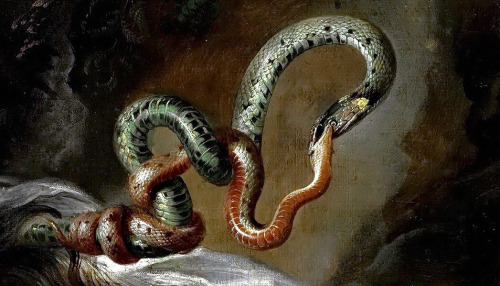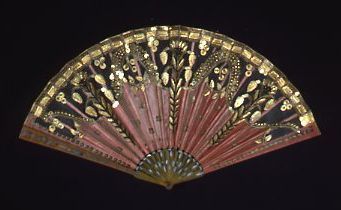What Is Your Favorite Obscure Greek Mythological Fact
What is your favorite obscure Greek mythological fact
Hm, probably the Orphic fragment that says that Persephone was born with a monstrous appearance (fragment 87 according to Athanassakis, fragment 58 in the translation of Otto Kern’s compilation of fragments at HellenicGods.org):
…"of the daughter of Zeus, whom he begat of his mother Rhea; or of Demeter, as having two eyes in the natural order, and two in her forehead, and the face of an animal on the back part of her neck, and as having also horns, so that Rhea, frightened at her monster of a child, fled from her, and did not give her the breast (θηλη), whence mystically she is called Athêlâ, but commonly Phersephoné and Koré"…
It's so totally different from all other versions that only describe her as very beautiful (as goddesses tend to be). Sometimes I regret that I didn't give my Persephone horns.
More Posts from Ro0hafz4 and Others
“The manifold self-contradictions in Greek ideas and phrasing about death are not errors. They are styles of imagining the unimaginable, and are responsive both to personal needs and to old conventions. The same conflicts surge up in many cultures. They are necessary ambiguities in a realm of thinking where thinking cannot really be done, and where there is no experience.”
— Emily Vermeule, “Immortals are Mortal, Mortals Immortal,” Aspects of Death in Early Greek Art and Poetry
But our notebooks give us away, for however dutifully we record what we see around us, the common denominator of all we see is always, transparently, shamelessly, the implacable “I.” We are not talking here about the kind of notebook that is patently for public consumption, a structural conceit for binding together a series of graceful pensées; we are talking about something private, about bits of the mind’s string too short to use, an indiscriminate and erratic assemblage with meaning only for its maker. And sometimes even the maker has difficulty with the meaning.
Joan Didion, from On Keeping A Notebook in: Slouching Towards Bethlehem


Image ID: An excepert, cut into two screenshots, from "The Archaeology of Caves in Ireland", by Marion Dowd, that reads:
DISAPPEARING UNDERGROUND
The idea that some ritual activities at caves involved people disappearing from view into darkness is powerful. In most cases only one individual or a small se- lect group could have entered caves at any one time. Thus the potentially public nature of early stages of some rituals, such as the entire community walking to a cave entrance, may have been juxtaposed by the secret activities that took place inside the cave involving just a few people. Witnessing this disappearance into darkness, and waiting for individuals to re-emerge, is likely to have been dramatic. The length of time spent inside a cave may have increased the feelings of anticipation, expectancy, anxiety, trepidation, fear or mystery experienced by those outside. People above ground were in the dark too. What was happening down there in the darkness? Who or what would be met in the cave? Why was the trip taking so long? Would s/he return? What would be the outcome?
These were religious and spiritual excursions into darkness that must have transformed those waiting outside but especially the person who had entered the cave. Such journeys may have conferred her/him with greater power, status, reverence or respect if caves were perceived as places of the Otherworld where it was possible to commune with the spirit world. Emerging from darkness and returning to the world of the living may have been seen as akin to a rebirth: emerging with new knowledge or insights, emerging as a new and transformed person.
/End ID
“The so-called ‘mystery cults’ were a handful of marginal Eastern Mediterranean cults which achieved popularity throughout the Roman empire and were distinguished as a unique religious phenomenon by the Belgian archaeologist and philologist Franz Cumont in his 1906 book Oriental Religions in Roman Paganism. This modern label of ‘mystery cults’ has now long been used as a blanket designation to cover the cults held in honour of Mithra, Attis and Cybele, Isis and Osiris, Demeter and Persephone, Orpheus and Bacchus/ Dionysus, and the Samothracian Kabeiroi, among countless other minor and local groups who will never be remembered. Each of these cults (with perhaps the exception of Mithraism) revolved around the dramatic and ecstatic veneration of “dying-and-rising-gods,” a title formulated by the founding father of comparative religion, James G. Frazer, and subsequently developed by British and Scandinavian members of the Myth-and-Ritual School. These so-called “Cambridge Ritualists,” held to the notion that myths do not stand on their own, but are born out of ritual. This theory, of course, is heavily disputed; but the alternative view is equally enlightening: that myth and ritual evolve along parallel lines, without one developing strictly out from the other. The ‘Divine Bridegroom’ is similarly a name I use for these dying mystery gods. For the most part, the mystery religions were sanctuary based, taking place in a telestrion (initiation chambers), caves, or mountain groves, and their members were organized by a structure of hierarchical degrees of initiation. The “mysteries” themselves generally entailed dramatic experiences conveyed via esoteric initiation ceremonies that were reflections of annual agricultural and astrological cycles. Already the mainstream view of old-school ethnologists believed in the notion that the mysteries were survivals of ancient “rites of passage,” especially by Mircea Eliade and Angelo Brelich. Many believed that the origin of the mysteries should be sought in some stage of primitive agricultural development, and it is in illo tempore - into that mythic dream time - to which I wish to return throughout this book.”
— Dan Attrell - Shamanism and the Mysteries: A Brief History of the Cult of Ecstasy
AND IF we’re talking about Ovid’s take on the Persephone myth anyway, and the other story Ovid inserted, the comparison between the boy being turned into a lizard for laughing at Demeter and the Demophon myth are so different in every single aspect that I cannot fathom what the use of the second one is to the Persephone myth, only to Ovid’s overall themes. While Demophon is a temporary stand-in for Persephone and perhaps even a tool Demeter uses to one-up her brothers, and is a cultic display of her matronly side as a goddess, the lizard tale just…provides comedy? Characterizes her as petty or fickle? It really is the most derailing story line in this part of the text, as Demeter is searching before it and after it. It only provides the mandatory metamorphosis, but so does Cyane? And the fun part is that the episode reflects the Homeric hymn in that Demeter is received as a guest and receives a specific type of food tied to her role as goddess of the grain, but here it has absolutely no payoff, nor any ambiguity to make us guess at more. It just…is.
-
 faefox9 liked this · 3 weeks ago
faefox9 liked this · 3 weeks ago -
 queermoronic liked this · 1 month ago
queermoronic liked this · 1 month ago -
 pink-lemonade-rose liked this · 4 months ago
pink-lemonade-rose liked this · 4 months ago -
 toixxx-ace liked this · 5 months ago
toixxx-ace liked this · 5 months ago -
 darknovalatte liked this · 5 months ago
darknovalatte liked this · 5 months ago -
 leftemperor liked this · 6 months ago
leftemperor liked this · 6 months ago -
 sejsoup reblogged this · 6 months ago
sejsoup reblogged this · 6 months ago -
 sejsoup liked this · 6 months ago
sejsoup liked this · 6 months ago -
 ro0hafz4 reblogged this · 6 months ago
ro0hafz4 reblogged this · 6 months ago -
 moonrisebutterfly reblogged this · 7 months ago
moonrisebutterfly reblogged this · 7 months ago -
 sunrisebutterfly liked this · 7 months ago
sunrisebutterfly liked this · 7 months ago -
 buriedpentacles liked this · 7 months ago
buriedpentacles liked this · 7 months ago -
 anteros2117 reblogged this · 7 months ago
anteros2117 reblogged this · 7 months ago -
 anteros2117 liked this · 7 months ago
anteros2117 liked this · 7 months ago -
 theic-manic reblogged this · 7 months ago
theic-manic reblogged this · 7 months ago -
 theic-manic liked this · 7 months ago
theic-manic liked this · 7 months ago -
 demonhen liked this · 8 months ago
demonhen liked this · 8 months ago -
 marysmirages liked this · 9 months ago
marysmirages liked this · 9 months ago -
 en-theos liked this · 9 months ago
en-theos liked this · 9 months ago -
 windshield-patent reblogged this · 11 months ago
windshield-patent reblogged this · 11 months ago -
 albi-bumblebee reblogged this · 11 months ago
albi-bumblebee reblogged this · 11 months ago -
 albi-bumblebee liked this · 11 months ago
albi-bumblebee liked this · 11 months ago -
 lady2grace liked this · 11 months ago
lady2grace liked this · 11 months ago -
 imperturbitude liked this · 11 months ago
imperturbitude liked this · 11 months ago -
 bat-anon liked this · 11 months ago
bat-anon liked this · 11 months ago -
 rebloggingbeautifularts reblogged this · 11 months ago
rebloggingbeautifularts reblogged this · 11 months ago -
 rebloggingbeautifularts liked this · 11 months ago
rebloggingbeautifularts liked this · 11 months ago -
 blueraiins liked this · 11 months ago
blueraiins liked this · 11 months ago -
 salty-vesta liked this · 11 months ago
salty-vesta liked this · 11 months ago -
 cheapsweets liked this · 11 months ago
cheapsweets liked this · 11 months ago -
 bookish-bimbo reblogged this · 11 months ago
bookish-bimbo reblogged this · 11 months ago -
 kick-a-long reblogged this · 11 months ago
kick-a-long reblogged this · 11 months ago -
 kick-a-long liked this · 11 months ago
kick-a-long liked this · 11 months ago -
 giulia-lo-art liked this · 11 months ago
giulia-lo-art liked this · 11 months ago -
 mask131 reblogged this · 11 months ago
mask131 reblogged this · 11 months ago -
 serpent-among-vines reblogged this · 11 months ago
serpent-among-vines reblogged this · 11 months ago -
 serpent-among-vines liked this · 11 months ago
serpent-among-vines liked this · 11 months ago -
 heart-beat-girl liked this · 11 months ago
heart-beat-girl liked this · 11 months ago -
 mellowsuitangel liked this · 11 months ago
mellowsuitangel liked this · 11 months ago -
 perculesspleen liked this · 11 months ago
perculesspleen liked this · 11 months ago -
 syntheros-artemidos liked this · 11 months ago
syntheros-artemidos liked this · 11 months ago -
 persephobeee reblogged this · 11 months ago
persephobeee reblogged this · 11 months ago -
 persephobeee liked this · 11 months ago
persephobeee liked this · 11 months ago -
 tiresian-ent liked this · 11 months ago
tiresian-ent liked this · 11 months ago


















